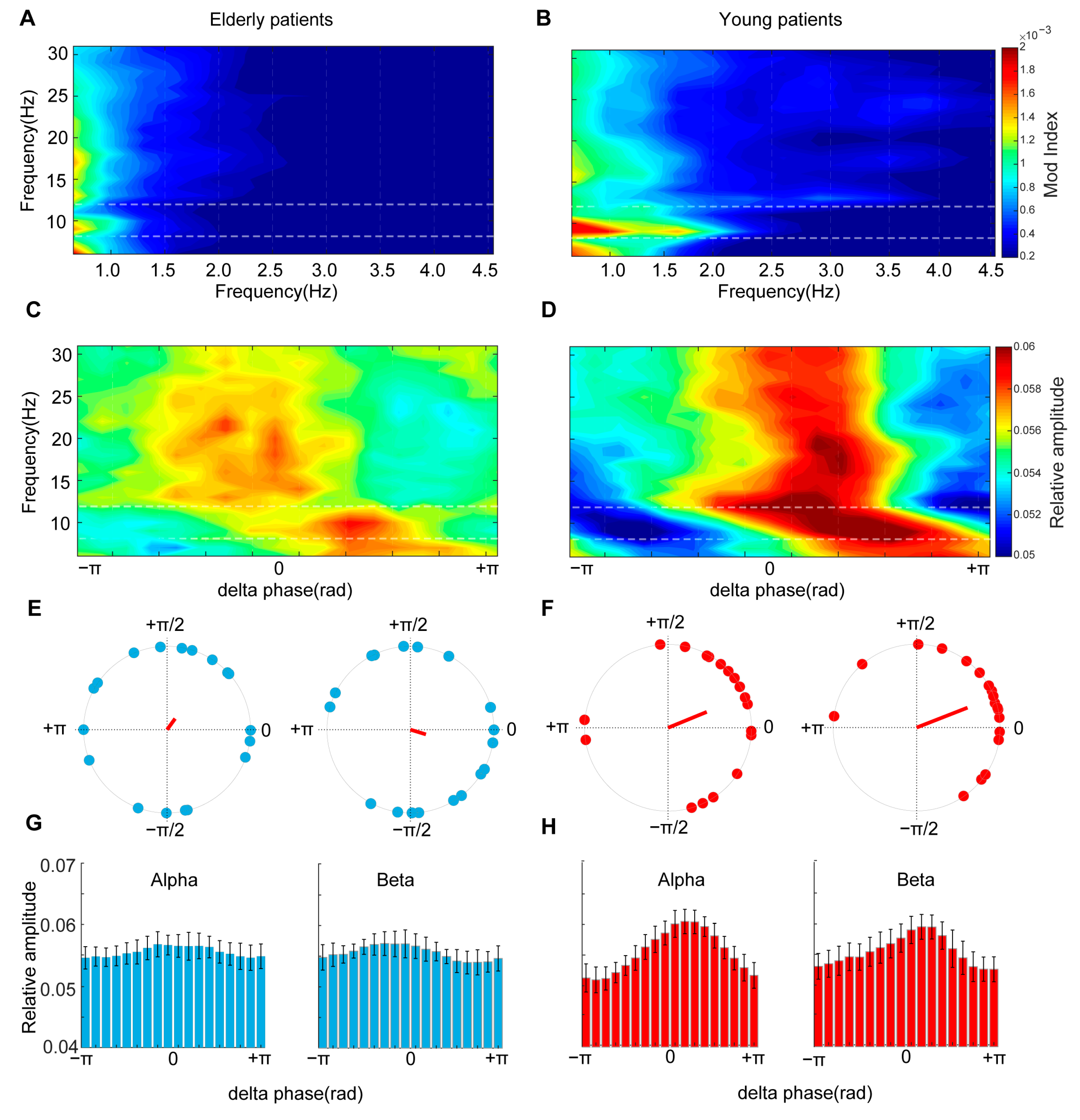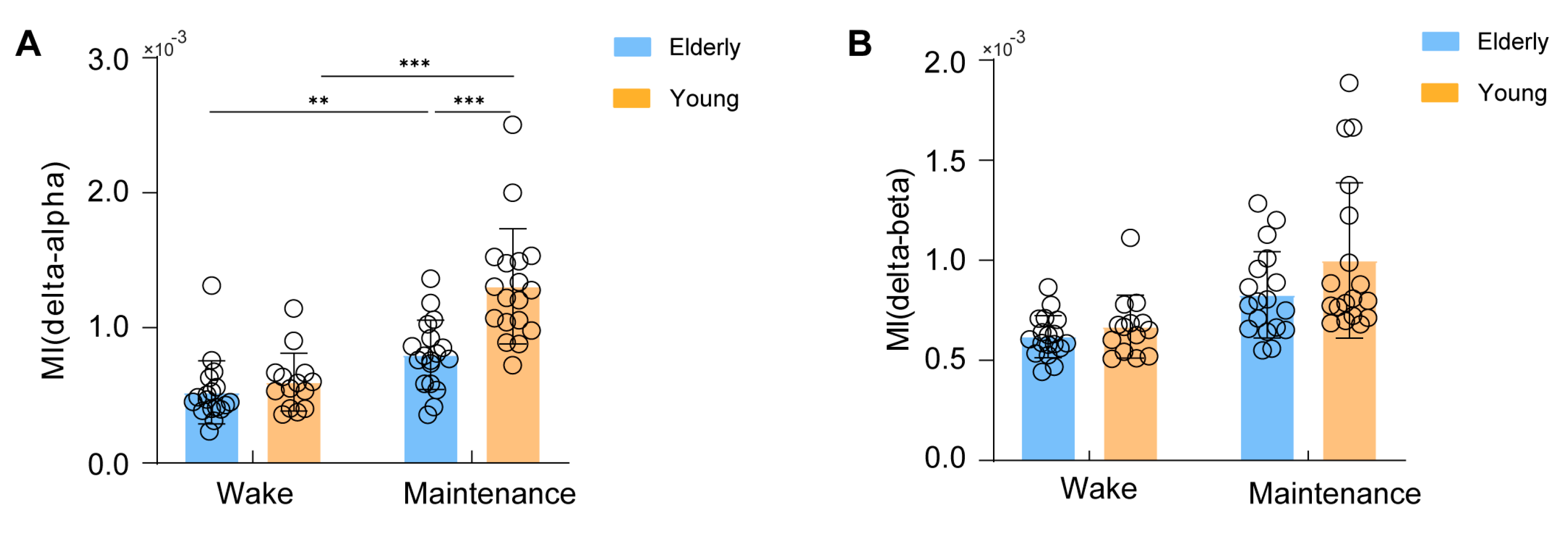Differences in the EEG Power Spectrum and Cross-Frequency Coupling Patterns between Young and Elderly Patients during Sevoflurane Anesthesia
Abstract
:1. Introduction
2. Materials and Methods
2.1. Ethical Approvement
2.2. Patient Selection
2.3. EEG Acquisition and Preprocessing
2.4. Spectral Analysis
2.5. Phase–Amplitude Coupling Analysis (PAC)
2.6. Statistical Analysis
3. Results
3.1. Both Elderly and Young Patients Exhibited Significant Alternations in EEG Spectrograms during General Anesthesia
3.2. Weak Cross-Frequency Couplings Were Exhibited before General Anesthesia
3.3. General Anesthesia Strengthened the Coupling of the Delta Phase with the Amplitudes of Higher-Frequency Oscillations
3.4. Phase–Amplitude Couplings between the Delta Phase and Alpha/Beta Amplitude Were Impaired in Elderly Patients during General Anesthesia
4. Discussion
5. Conclusions
Author Contributions
Funding
Institutional Review Board Statement
Informed Consent Statement
Data Availability Statement
Acknowledgments
Conflicts of Interest
References
- Purdon, P.L.; Sampson, A.; Pavone, K.J.; Brown, E.N. Clinical Electroencephalography for Anesthesiologists: Part I: Background and Basic Signatures. Anesthesiology 2015, 123, 937–960. [Google Scholar] [CrossRef] [Green Version]
- Avidan, M.S.; Zhang, L.; Burnside, B.A.; Finkel, K.J.; Searleman, A.C.; Selvidge, J.A.; Saager, L.; Turner, M.S.; Rao, S.; Bottros, M.; et al. Anesthesia awareness and the bispectral index. N. Engl. J. Med. 2008, 358, 1097–1108. [Google Scholar] [CrossRef]
- Fu, Y.; Xu, T.; Xie, K.; Wei, W.; Gao, P.; Nie, H.; Deng, X.; Wang, G.; Tian, M.; Yan, M.; et al. Comparative Evaluation of a New Depth of Anesthesia Index in ConView® System and the Bispectral Index during Total Intravenous Anesthesia: A Multicenter Clinical Trial. Biomed. Res. Int. 2019, 2019, 1014825. [Google Scholar] [CrossRef]
- Punjasawadwong, Y.; Chau-In, W.; Laopaiboon, M.; Punjasawadwong, S.; Pin-On, P. Processed electroencephalogram and evoked potential techniques for amelioration of postoperative delirium and cognitive dysfunction following non-cardiac and non-neurosurgical procedures in adults. Cochrane Database Syst. Rev. 2018, 5, CD011283. [Google Scholar] [CrossRef]
- Purdon, P.L.; Pavone, K.J.; Akeju, O.; Smith, A.C.; Sampson, A.L.; Lee, J.; Zhou, D.W.; Solt, K.; Brown, E.N. The Ageing Brain: Age-dependent changes in the electroencephalogram during propofol and sevoflurane general anaesthesia. Br. J. Anaesth. 2015, 115 (Suppl. S1), i46–i57. [Google Scholar] [CrossRef] [Green Version]
- Kreuzer, M.; Stern, M.A.; Hight, D.; Berger, S.; Schneider, G.; Sleigh, J.W.; García, P.S. Spectral and Entropic Features Are Altered by Age in the Electroencephalogram in Patients under Sevoflurane Anesthesia. Anesthesiology 2020, 132, 1003–1016. [Google Scholar] [CrossRef]
- Koch, S.; Feinkohl, I.; Chakravarty, S.; Windmann, V.; Lichtner, G.; Pischon, T.; Brown, E.N.; Spies, C. Cognitive Impairment Is Associated with Absolute Intraoperative Frontal α-Band Power but Not with Baseline α-Band Power: A Pilot Study. Dement. Geriatr. Cogn. Disord. 2019, 48, 83–92. [Google Scholar] [CrossRef]
- Giattino, C.M.; Gardner, J.E.; Sbahi, F.M.; Roberts, K.C.; Cooter, M.; Moretti, E.; Browndyke, J.N.; Mathew, J.P.; Woldorff, M.G.; Berger, M. Intraoperative Frontal Alpha-Band Power Correlates with Preoperative Neurocognitive Function in Older Adults. Front. Syst. Neurosci. 2017, 11, 24. [Google Scholar] [CrossRef] [Green Version]
- Shao, Y.R.; Kahali, P.; Houle, T.T.; Deng, H.; Colvin, C.; Dickerson, B.C.; Brown, E.N.; Purdon, P.L. Low Frontal Alpha Power Is Associated With the Propensity for Burst Suppression: An Electroencephalogram Phenotype for a “Vulnerable Brain”. Anesth. Analg. 2020, 131, 1529–1539. [Google Scholar] [CrossRef]
- Chan, M.T.V.; Cheng, B.C.P.; Lee, T.M.C.; Gin, T. BIS-guided anesthesia decreases postoperative delirium and cognitive decline. J. Neurosurg. Anesthesiol. 2013, 25, 33–42. [Google Scholar] [CrossRef]
- Shortal, B.P.; Hickman, L.B.; Mak-McCully, R.A.; Wang, W.; Brennan, C.; Ung, H.; Litt, B.; Tarnal, V.; Janke, E.; Picton, P.; et al. Duration of EEG suppression does not predict recovery time or degree of cognitive impairment after general anaesthesia in human volunteers. Br. J. Anaesth. 2019, 123, 206–218. [Google Scholar] [CrossRef]
- Fritz, B.A.; King, C.R.; Mickle, A.M.; Wildes, T.S.; Budelier, T.P.; Oberhaus, J.; Park, D.; Maybrier, H.R.; Ben Abdallah, A.; Kronzer, A.; et al. Effect of electroencephalogram-guided anaesthesia administration on 1-yr mortality: Follow-up of a randomised clinical trial. Br. J. Anaesth. 2021, 127, 386–395. [Google Scholar] [CrossRef]
- Wildes, T.S.; Mickle, A.M.; Ben Abdallah, A.; Maybrier, H.R.; Oberhaus, J.; Budelier, T.P.; Kronzer, A.; McKinnon, S.L.; Park, D.; Torres, B.A.; et al. Effect of Electroencephalography-Guided Anesthetic Administration on Postoperative Delirium among Older Adults Undergoing Major Surgery: The ENGAGES Randomized Clinical Trial. JAMA 2019, 321, 473–483. [Google Scholar] [CrossRef] [Green Version]
- Obert, D.P.; Schweizer, C.; Zinn, S.; Kratzer, S.; Hight, D.; Sleigh, J.; Schneider, G.; García, P.S.; Kreuzer, M. The influence of age on EEG-based anaesthesia indices. J. Clin. Anesth. 2021, 73, 110325. [Google Scholar] [CrossRef]
- Biggs, D.; Boncompte, G.; Pedemonte, J.C.; Fuentes, C.; Cortinez, L.I. The effect of age on electroencephalogram measures of anesthesia hypnosis: A comparison of BIS, Alpha Power, Lempel-Ziv complexity and permutation entropy during propofol induction. Front. Aging Neurosci. 2022, 14, 910886. [Google Scholar] [CrossRef]
- Helfrich, R.F.; Mander, B.A.; Jagust, W.J.; Knight, R.T.; Walker, M.P. Old Brains Come Uncoupled in Sleep: Slow Wave-Spindle Synchrony, Brain Atrophy, and Forgetting. Neuron 2018, 97, 221–230. [Google Scholar] [CrossRef] [Green Version]
- Purdon, P.L.; Pierce, E.T.; Mukamel, E.A.; Prerau, M.J.; Walsh, J.L.; Wong, K.F.K.; Salazar-Gomez, A.F.; Harrell, P.G.; Sampson, A.L.; Cimenser, A.; et al. Electroencephalogram signatures of loss and recovery of consciousness from propofol. Proc. Natl. Acad. Sci. USA 2013, 110, E1142–E1151. [Google Scholar] [CrossRef]
- Chamadia, S.; Pedemonte, J.C.; Hahm, E.Y.; Mekonnen, J.; Ibala, R.; Gitlin, J.; Ethridge, B.R.; Qu, J.; Vazquez, R.; Rhee, J.; et al. Delta oscillations phase limit neural activity during sevoflurane anesthesia. Commun. Biol. 2019, 2, 415. [Google Scholar] [CrossRef]
- de Hemptinne, C.; Swann, N.C.; Ostrem, J.L.; Ryapolova-Webb, E.S.; San Luciano, M.; Galifianakis, N.B.; Starr, P.A. Therapeutic deep brain stimulation reduces cortical phase-amplitude coupling in Parkinson’s disease. Nat. Neurosci. 2015, 18, 779–786. [Google Scholar] [CrossRef]
- Tort, A.B.L.; Komorowski, R.; Eichenbaum, H.; Kopell, N. Measuring phase-amplitude coupling between neuronal oscillations of different frequencies. J. Neurophysiol. 2010, 104, 1195–1210. [Google Scholar] [CrossRef]
- Shuman, T.; Aharoni, D.; Cai, D.J.; Lee, C.R.; Chavlis, S.; Page-Harley, L.; Vetere, L.M.; Feng, Y.; Yang, C.Y.; Mollinedo-Gajate, I.; et al. Breakdown of spatial coding and interneuron synchronization in epileptic mice. Nat. Neurosci. 2020, 23, 229–238. [Google Scholar] [CrossRef]
- Aranake, A.; Mashour, G.A.; Avidan, M.S. Minimum alveolar concentration: Ongoing relevance and clinical utility. Anaesthesia 2013, 68, 512–522. [Google Scholar] [CrossRef] [Green Version]
- Gaál, Z.A.; Boha, R.; Stam, C.J.; Molnár, M. Age-dependent features of EEG-reactivity—spectral, complexity, and network characteristics. Neurosci. Lett. 2010, 479, 79–84. [Google Scholar] [CrossRef]
- Ching, S.; Cimenser, A.; Purdon, P.L.; Brown, E.N.; Kopell, N.J. Thalamocortical model for a propofol-induced alpha-rhythm associated with loss of consciousness. Proc. Natl. Acad. Sci. USA 2010, 107, 22665–22670. [Google Scholar] [CrossRef]
- Babiloni, C.; Binetti, G.; Cassarino, A.; Dal Forno, G.; Del Percio, C.; Ferreri, F.; Ferri, R.; Frisoni, G.; Galderisi, S.; Hirata, K.; et al. Sources of cortical rhythms in adults during physiological aging: A multicentric EEG study. Hum. Brain Mapp. 2006, 27, 162–172. [Google Scholar] [CrossRef] [Green Version]
- Weiner, V.S.; Zhou, D.W.; Kahali, P.; Stephen, E.P.; Peterfreund, R.A.; Aglio, L.S.; Szabo, M.D.; Eskandar, E.N.; Salazar-Gomez, A.F.; Sampson, A.L.; et al. Propofol disrupts alpha dynamics in functionally distinct thalamocortical networks during loss of consciousness. Proc. Natl. Acad. Sci. USA 2023, 120, e2207831120. [Google Scholar] [CrossRef]
- McGinnis, S.M.; Brickhouse, M.; Pascual, B.; Dickerson, B.C. Age-related changes in the thickness of cortical zones in humans. Brain Topogr. 2011, 24, 279–291. [Google Scholar] [CrossRef] [Green Version]
- Cornelissen, L.; Kim, S.E.; Lee, J.M.; Brown, E.N.; Purdon, P.L.; Berde, C.B. Electroencephalographic markers of brain development during sevoflurane anaesthesia in children up to 3 years old. Br. J. Anaesth. 2018, 120, 1274–1286. [Google Scholar] [CrossRef] [Green Version]
- Pedemonte, J.C.; Plummer, G.S.; Chamadia, S.; Locascio, J.J.; Hahm, E.; Ethridge, B.; Gitlin, J.; Ibala, R.; Mekonnen, J.; Colon, K.M.; et al. Electroencephalogram Burst-suppression during Cardiopulmonary Bypass in Elderly Patients Mediates Postoperative Delirium. Anesthesiology 2020, 133, 280–292. [Google Scholar] [CrossRef]
- Koch, S.; Windmann, V.; Chakravarty, S.; Kruppa, J.; Yürek, F.; Brown, E.N.; Winterer, G.; Spies, C. Perioperative Electroencephalogram Spectral Dynamics Related to Postoperative Delirium in Older Patients. Anesth. Analg. 2021, 133, 1598–1607. [Google Scholar] [CrossRef]
- Lendner, J.D.; Helfrich, R.F.; Mander, B.A.; Romundstad, L.; Lin, J.J.; Walker, M.P.; Larsson, P.G.; Knight, R.T. An electrophysiological marker of arousal level in humans. Elife 2020, 9, e55092. [Google Scholar] [CrossRef]
- Malekmohammadi, M.; Price, C.M.; Hudson, A.E.; DiCesare, J.A.T.; Pouratian, N. Propofol-induced loss of consciousness is associated with a decrease in thalamocortical connectivity in humans. Brain 2019, 142, 2288–2302. [Google Scholar] [CrossRef]
- Huang, Y.; Wu, D.; Bahuri, N.F.A.; Wang, S.; Hyam, J.A.; Yarrow, S.; FitzGerald, J.J.; Aziz, T.Z.; Green, A.L. Spectral and phase-amplitude coupling signatures in human deep brain oscillations during propofol-induced anaesthesia. Br. J. Anaesth. 2018, 121, 303–313. [Google Scholar] [CrossRef] [Green Version]
- Soplata, A.E.; McCarthy, M.M.; Sherfey, J.; Lee, S.; Purdon, P.L.; Brown, E.N.; Kopell, N. Thalamocortical control of propofol phase-amplitude coupling. PLoS Comput. Biol. 2017, 13, e1005879. [Google Scholar] [CrossRef]
- Goyal, M.S.; Vlassenko, A.G.; Blazey, T.M.; Su, Y.; Couture, L.E.; Durbin, T.J.; Bateman, R.J.; Benzinger, T.L.S.; Morris, J.C.; Raichle, M.E. Loss of Brain Aerobic Glycolysis in Normal Human Aging. Cell Metab. 2017, 26, 353–360. [Google Scholar] [CrossRef]
- Hayashi, K.; Indo, K.; Sawa, T. Anaesthesia-dependent oscillatory EEG features in the super-elderly. Clin. Neurophysiol. 2020, 131, 2150–2157. [Google Scholar] [CrossRef]
- Gutiérrez, R.G.; Egaña, J.I.; Maldonado, F.A.; Sáez, I.A.; Reyes, F.I.; Soulat, H.; Purdon, P.L.; Penna, A. Association between Lower Preoperative Cognition with Intraoperative Electroencephalographic Features Consistent with Deep States of Anesthesia in Older Patients: An Observational Cohort Study. Anesth. Analg. 2021, 133, 205–214. [Google Scholar] [CrossRef]




| Variable | Young Patients (n = 21) | Elderly Patients (n = 20) | p Value |
|---|---|---|---|
| Age (yr) | 33.00 (30.00, 35.00) | 67.00 (65.25, 71.25) | <0.0001 |
| Male (%) | 23.81 | 40.00 | 0.3264 |
| Weight (kg) | 61.90 (±13.80) | 62.58 (±9.82) | 0.8594 |
| ASA | 0.3433 | ||
| I | 4 (19.05%) | 1 (5%) | |
| II | 17 (80.95%) | 19 (95%) | |
| Length of surgery (min) | 128.6 (±57.08) | 153.3 (±64.01) | 0.2104 |
| Length of anesthesia (min) | 167.1 (±61.33) | 189.1 (±68.82) | 0.2988 |
| Induction | |||
| Propofol (mg) | 120.0 (100.0, 135.0) | 100.0 (81.25,100.0) | 0.0031 |
| Rocuronium (mg) | 50.00 (40.00, 50.00) | 50.00 (40.00, 50.00) | 0.0975 |
| Maintenance | |||
| Sevoflurane (%) | 2.22 (2.00, 2.31) | 1.87 (1.81, 1.90) | <0.0001 |
| MAC 1 | 0.99 (0.92, 1.05) | 1.06 (1.02, 1.08) | 0.0013 |
| Remifentanil (μg/kg/min) | 0.15 (0.15, 0.15) | 0.15 (0.15, 0.20) | 0.5133 |
| Total rocuronium (mg) | 50.00 (50.00, 60.00) | 50.00 (40.00, 70.00) | 0.9570 |
Disclaimer/Publisher’s Note: The statements, opinions and data contained in all publications are solely those of the individual author(s) and contributor(s) and not of MDPI and/or the editor(s). MDPI and/or the editor(s) disclaim responsibility for any injury to people or property resulting from any ideas, methods, instructions or products referred to in the content. |
© 2023 by the authors. Licensee MDPI, Basel, Switzerland. This article is an open access article distributed under the terms and conditions of the Creative Commons Attribution (CC BY) license (https://creativecommons.org/licenses/by/4.0/).
Share and Cite
Zhang, X.; Li, A.; Wang, S.; Wang, T.; Liu, T.; Wang, Y.; Fu, J.; Zhao, G.; Yang, Q.; Dong, H. Differences in the EEG Power Spectrum and Cross-Frequency Coupling Patterns between Young and Elderly Patients during Sevoflurane Anesthesia. Brain Sci. 2023, 13, 1149. https://doi.org/10.3390/brainsci13081149
Zhang X, Li A, Wang S, Wang T, Liu T, Wang Y, Fu J, Zhao G, Yang Q, Dong H. Differences in the EEG Power Spectrum and Cross-Frequency Coupling Patterns between Young and Elderly Patients during Sevoflurane Anesthesia. Brain Sciences. 2023; 13(8):1149. https://doi.org/10.3390/brainsci13081149
Chicago/Turabian StyleZhang, Xinxin, Ao Li, Sa Wang, Tingting Wang, Tiantian Liu, Yonghui Wang, Jingwen Fu, Guangchao Zhao, Qianzi Yang, and Hailong Dong. 2023. "Differences in the EEG Power Spectrum and Cross-Frequency Coupling Patterns between Young and Elderly Patients during Sevoflurane Anesthesia" Brain Sciences 13, no. 8: 1149. https://doi.org/10.3390/brainsci13081149






